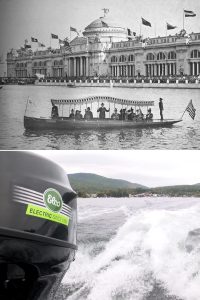World’s First Electric Boat Motors Still Trailblazing
Elco powers top competitors in fishing tournaments focused on electric-only lakes and reservoirs where pristine waters teem with monster bass. Coastal anglers similarly enjoy stealthy electric shallow-water access.

Since its first pleasure launches peacefully plied the man-made lagoons of the 1893 Chicago World’s Fair, Elco Motor Yachts has pioneered clean electric marine propulsion. This year, the company celebrates the results of 130 years of successful trailblazing. Appropriate to the occasion, the industry leader kicked off its anniversary festivities at the Chicago Boat Show.
Back In The Day
At the dawn of electrification, steam still powered most boats, so riding aboard a battery-driven 36′ boat at the World’s Fair was a novel experience. Built by the Electric Launch Company, as Elco was known then, the vessels made 66,000 three-mile trips and carried more than a million passengers. Notables such as Henry Ford, Thomas Edison and John Jacob Astor quickly became customers. To this day, the company still builds luxury launches reminiscent of the golden age of yachting.
Elco has never been shy about adopting the newest ideas and technologies. The company was the first boatbuilder to adopt methods of standardized mass production. It even introduced the world’s first boat showroom, Port Elco in Midtown Manhattan, and the offer of direct financing and post-purchase continuous care.
At Turn Of Last Century
Beginning at the turn of the last century, when Exide Battery founder Isaac Rice acquired both Elco and Holland Submarine, the newly formed Electric Boat Company advanced battery-powered propulsion beneath the waves to develop the US Navy’s submarine fleet. While the company continued to advance recreational craft, its production line built 550 Elco Motor Torpedo Boats for the United Kingdom during World War I and another 326 US Patrol Torpedo Boats in World War II. This included then Lt. John F. Kennedy’s PT-109 as well as his lesser-known next command, PT-59.
At the start of the Cold War, Elco was a small branch within General Dynamics Corporation. A corporate reorganization shifted focus to naval submarines and a newly acquired aircraft division, causing Elco’s pleasure boat efforts to linger.
Everything Changed
Everything changed in 1987 when a new company took on Elco’s banner and leveraged then-new solid-state motor controller technology. The move reintroduced battery-powered electric propulsion aboard recreational boats, resulting in a renaissance of Elco’s iconic classic launches. In 2009, the company expanded into outboard motors and focused on powering the emerging electric-boat-propulsion market.
Today, Elco offers a full range of safe and reliable electric inboard and outboard motor systems with power up to 200 hp. Compact and virtually maintenance-free, recreational boaters and commercial operators alike appreciate the lack of warm-up time, instant throttle response, impressive torque and a quiet, exhaust-free ride.
Diverse Range
Elco propulsion solutions power a diverse range of modern applications throughout the world. In Australia, for example, Elco inboard motors provide sustainable power cruising aboard luxury catamarans where all propulsion and house electrical needs come entirely from batteries charged by solar arrays and backup hybrid diesel power.
Elco powers top competitors in fishing tournaments focused on electric-only lakes and reservoirs where pristine waters teem with monster bass. Coastal anglers similarly enjoy stealthy electric shallow-water access.
Proud To Continue
It’s been nearly a decade since the New York State Canal System repowered its 40-foot tug’s 6-cylinder Detroit Diesel with clean, quiet and smooth Elco inboard electric power. With increased horsepower, the workboat operates for an entire day on batteries alone. Of course, this is nothing new: Elco has been successfully powering electric yachts and workboats since 1893.
“We’re proud to continue Elco’s 130-year tradition of innovation,” said Steve Lamando, Elco president. “With a global shift towards sustainable alternatives to combustion engines, we are well positioned to continue trailblazing electric marine propulsion with new products and technologies.”






























